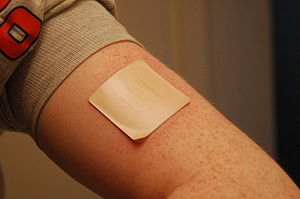Nicotine patch

A nicotine patch is a
Nicotine replacement products including gum and transdermal patches are on the World Health Organization's List of Essential Medicines.[1]
Medical uses
Effectiveness
A meta-analysis found that fewer than 20% of people treated with nicotine replacement therapy remain abstinent from smoking at one year.[2]
History
The first study of the pharmacokinetics of a transdermal nicotine patch in humans was published in 1984[3] by Jed Rose, Murray Jarvik, and Daniel Rose, and was followed by publication by Rose et al. (1985) of results of a study of smokers showing that a transdermal nicotine patch reduced craving for cigarettes.[4] Frank Etscorn filed a patent in the United States on January the 23rd 1985 and was issued the patent on July 1, 1986.[5] The University of California filed a competing patent application nearly three years after Etscorn's filing on February 19, 1988, which was granted on May 1, 1990.[6] Subsequently, the U.S. Patent Office declared an interference action and, after a thorough review of conception, reduction to practice and patent filing dates, issued on September 29, 1993, a priority decision in favor of the Rose et al. patent.[7]
Research
Research has shown that NRT in combination with
Nicotine patches are under study to help relieve the symptoms of
Studies are being conducted about the use of transdermal nicotine patches to treat anxiety, depression, and inattentiveness in subjects with
Two small studies have shown that transdermal nicotine patches improve some symptoms of ulcerative colitis.[15] However, this is not the case with Crohn's disease, a similar health condition, where smoking and nicotine intake in general worsen the disease's effects.
Application
The patch is typically worn for 16 to 24 hours.[16] Patches can be removed at night prior to bed if vivid dreams are experienced and undesirable.[17]
Side effects
A study published in the medical journal JAMA Internal Medicine in 2015 found that the most common side effects experienced when using a nicotine patch include: cough, headache, nausea, light-headedness, insomnia, disturbing dreams, sweating, watery eyes, shortness of breath, and skin irritation at the application site. The same study found that the following side effects were reported by patch wearers less frequently: diarrhea, dizziness, coldness in limbs, vomiting, and fast or pounding heart beat.[18]
Availability
Nicotine patches are available for purchase over-the-counter from various manufacturers, without a prescription.[19]
| NicoDerm CQ patch strength | For a person who smokes 10 or fewer cigarettes per day | For a person who smokes more than 10 cigarettes per day |
|---|---|---|
| 21 mg | Do not use this patch strength. | Step 1: Apply 1 patch per day for 6 weeks |
| 14 mg | Step 1: Apply 1 patch per day for 6 weeks | Step 2: Apply 1 patch per day for 2 weeks |
| 7 mg | Step 2: Apply 1 patch per day for 2 weeks | Step 3: Apply 1 patch per day for 2 weeks |
| Total Patch Treatment Period: 8 weeks | Total Patch Treatment Period: 10 weeks |
See also
References
- hdl:10665/325771. WHO/MVP/EMP/IAU/2019.06. License: CC BY-NC-SA 3.0 IGO.
- ^ PMID 29377409.
- PMID 6734425.
- S2CID 19915646.
- ^ US 4597961, Etscorn, FT
- ^ US 4920989
- ^ OLIVIA M. DUVALL (21 February 1995). "Adverse Decisions in Interference". Board of Patent Appeals & Interferences. Retrieved 25 November 2013.
- ISSN 1062-2551.
- PMID 6863699.
- ISSN 1062-6417.
- ^ "Nicotine Patch Decreases Post Surgical Pain". MediLexicon International Ltd, Bexhill-on-Sea, UK. 15 October 2007. Retrieved 25 November 2013.
- ^ "Nicotine Patches Up Early Memory Loss In Study". NPR. 9 January 2013. Retrieved 3 February 2014.
- PMID 18615164.
- ^ "Nicotine Patch May Help Late-Life Depression". Medscape. 21 March 2018. Retrieved 24 March 2018.
- ^ Cheah M, Khanna R (2019). "Current Medical Therapies for Ulcerative Colitis.". Pouchitis and Ileal Pouch Disorders. Academic Press. pp. 1–15.
- ^ "Nicotine Replacement Therapy for Quitting Tobacco". www.cancer.org. Retrieved 2019-10-23.
- ^ "Nicotine replacement therapy: MedlinePlus Medical Encyclopedia". medlineplus.gov. Retrieved 2019-10-23.
- PMID 25705872.
- ^ Commissioner Office (2019-03-22). "Want to Quit Smoking? FDA-Approved Products Can Help". FDA.
- ^ "Drugs@FDA: FDA Approved Drug Products". www.accessdata.fda.gov. Retrieved 2019-10-23.
